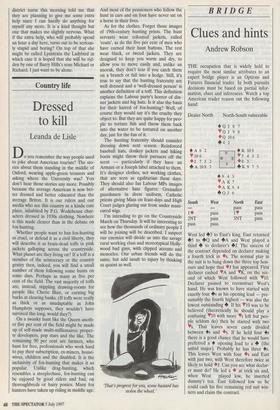BRIDGE
Clues and hints
Andrew Robson
THE occupation that is widely held to require the most similar attributes to an expert bridge player is an Options and Futures financial trader. In both pursuits decisions must be based on partial infor- mation, clues and inferences. Watch a top American trader reason out the following hand: Dealer North North-South vulnerable 4QJ 8 7 1PQ J 9 8
• Q 106 44 2
4A 6 2 V 10 6
• J 7 5 2 4A108 3
N
W E S
4 K105 V5 4 3 2
• 8 3 4K9 7 5
49 4 3 VA K7
• A K 9 4 4QJ 6
South 1* 2NT pass West pass pass pass North pass l• 3NT East pass pass pass West led +3 to East's king. East returned +5 to +0 and +A and West played a third 4 to declarer's +J. The success of the contract depended on declarer making a fourth trick in •s. The normal play in the suit is to bang down the three top hon- ours and hope that •I has appeared. First declarer cashed VA and Vic on the sec- ond of which West followed with •10. Declarer paused to reconstruct West's hand. He was known to have started with exactly four +s as his opening lead — pre- sumably the fourth highest — was also the lowest outstanding +. If his •10 was to be believed (theoretically he should play a confusing 1,10 with more Vs left but peo- ple seldom do) then he started with two Ts. That leaves seven cards divided between 4s and •s. If he held four 4s there is a good chance that he would have preferred a 4 opening lead to a 40 (the unbid major). Probably he has three 4s. This leaves West with four •s and East with just two, with West therefore twice as likely to hold +J. Can you see what declar- er must do? He led a • at trick six and, when West played low, he inserted dummy's ten. East followed low so he could cash his five remaining red suit win- ners and claim the contract.


























































 Previous page
Previous page